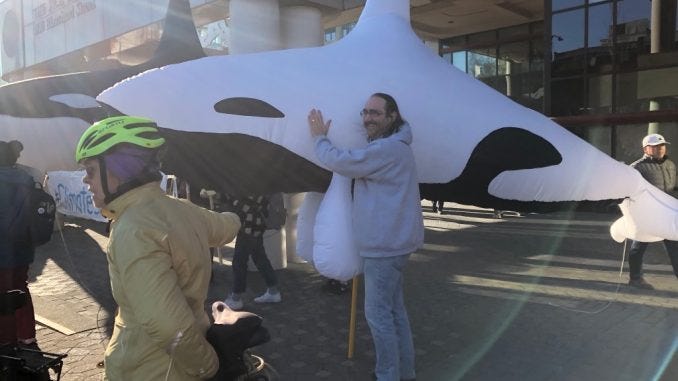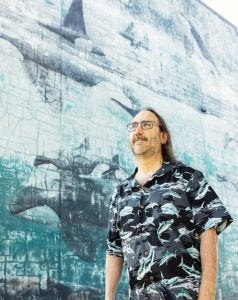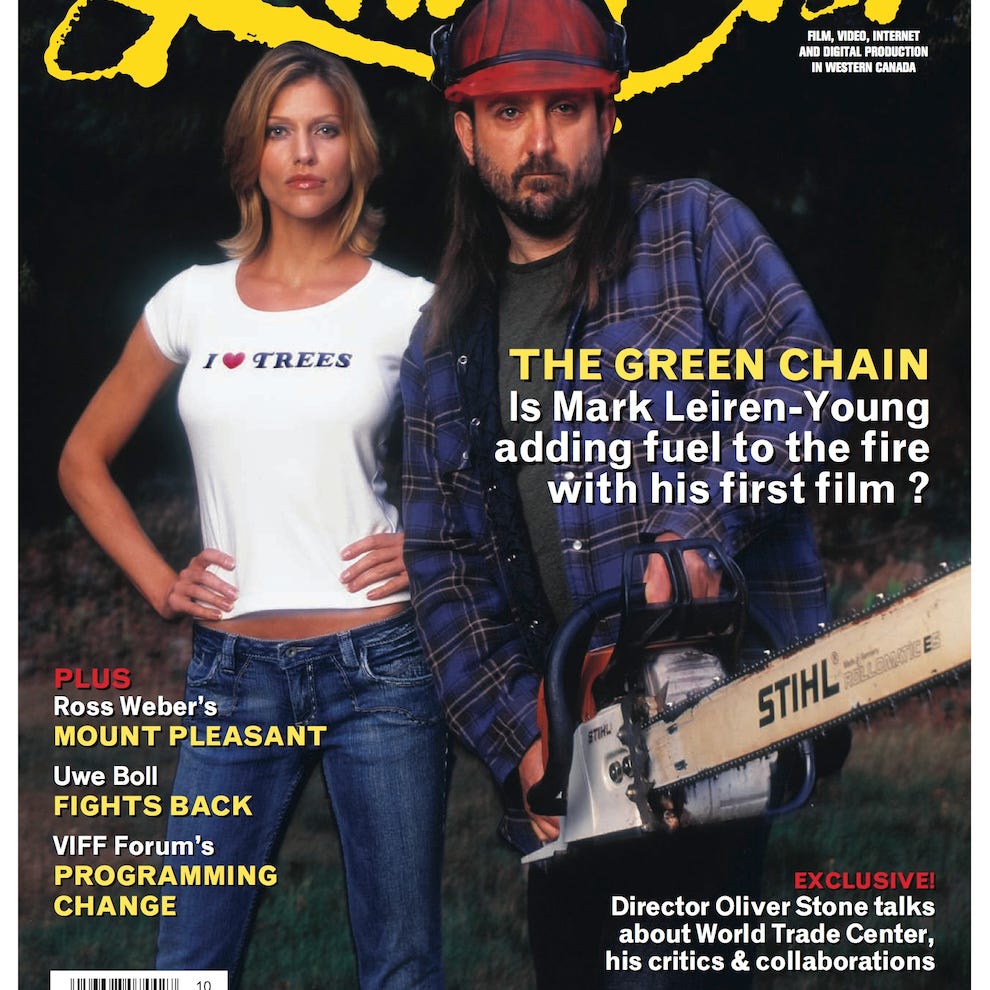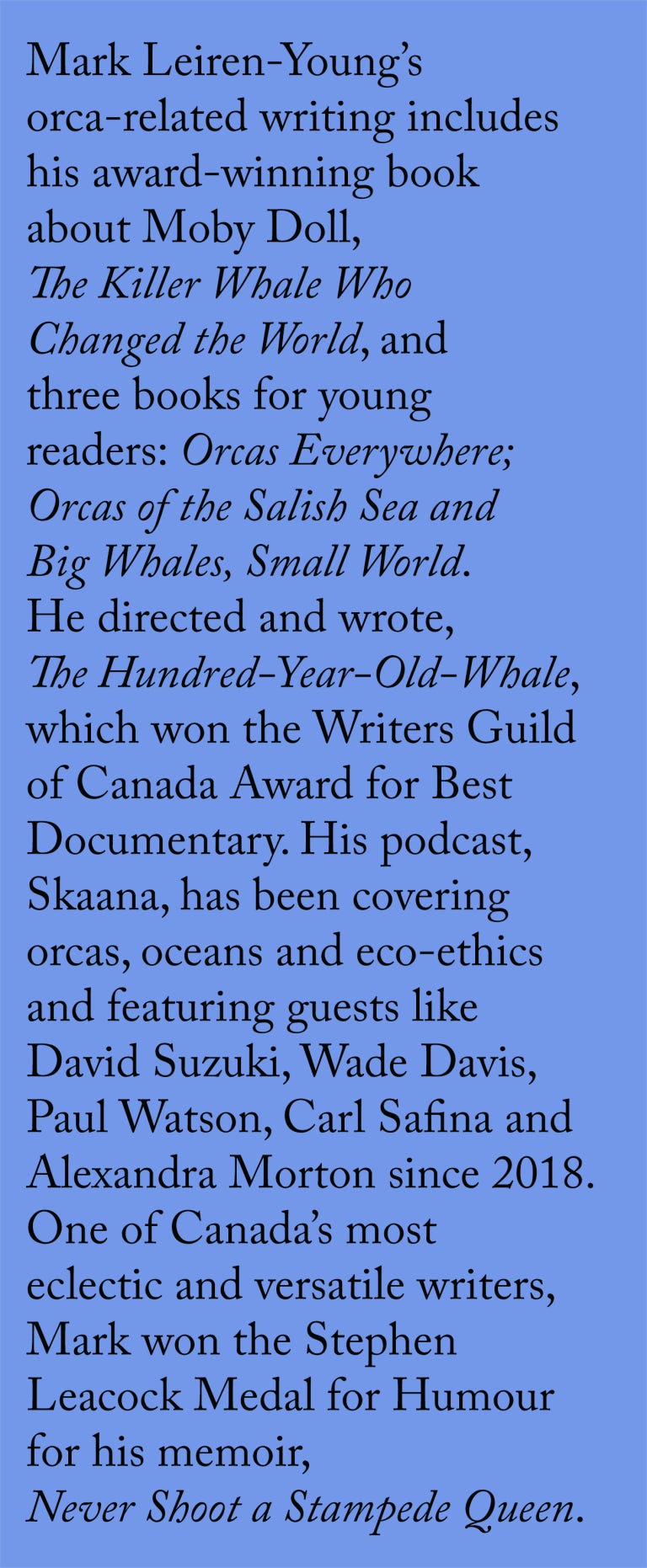Mark hanging out with an inflatable “spirit orca” at a climate rally in Victoria, BC.
This article is reprinted with permission from January Magazine (Oct. 18, 2023)
Tekteksen, or East Point, Saturna Island. August 10, 2018.
Sixty people collected on the grass overlooking the Salish Sea. They cross their legs, lean back on their hands, fumble to take pictures of the fading sky. They had gathered to listen to a talk about the southern resident orcas. In the distance, past the sculpted sandstone cliffs stood the San Juan Islands and a view of Mount Baker. The East Point Lighthouse harpooned the dusky sky.
Saturna Island was the ideal spot for whale-watchers wanting a glimpse of the southern resident or transient orcas. East Point was home to the historic site where Moby Doll was captured, the first live orca to be displayed to the public. At the time of his capture, nobody called them orcas. The widespread public belief was that they were killers.
Mark Leiren-Young prepared to speak to the audience gathered before him. That summer night wasn’t like any other—it was his farewell. After more than 20 years dedicated to sharing orcas’ stories, he had decided he was done.
The first time Mark saw a whale, he was only five years old. It was 1967 and the Vancouver Aquarium had just purchased their second ever killer whale. Her name was Skana. She had been captured in a pod of 15 whales. Seven were released, three drowned and five were taken into captivity.
Mark and his younger brother stood in the splash zone, thrilled to be as close as possible to the young orca. When she leaped out of the salinated pool and crashed back down, she sent a huge splash over the waiting children. They screamed and laughed.
Skana’s name comes from the Haida Nation, meaning killer whale or “spirit being.” During her time at the Vancouver Aquarium, she brought in hundreds of thousands of visitors. She died in captivity at age 17. In the wild, female orcas can live up to 90.
When asked if he’s willing to be interviewed about orcas, Mark’s face lights up. We stand at the bottom of an empty lecture hall after viewing Batman by Tim Burton. As an adjunct professor at the University of Victoria, he’s known to mention orcas at least once in all of his courses—even those centered around the Marvel and DC Universes. He cares a lot about his work and you can feel it in the way he talks: gesturing with his arms, a smile in his voice, speaking 200 words a minute.
Mark has been described by the National Post as “Canada’s go-to guy for dolphins, whales and trees.” They’re not wrong. A self-diagnosed “orcaholic” with a goofy grin, a wardrobe I’m convinced is only T-shirts with whale graphics, and shoulder-length “hippie” hair, he promises to always “do all I can to fight the good fights.” There’s a concept—tikkun olam—that Mark describes as “the Jewish version of karma” that is important to his work. The translation: healing the world. He says, no matter how commercial his writing assignments are, “I seem to be hard-wired to put something positive into it.”
Mark’s professional interest in orcas began with Moby Doll. In 1996, he discovered the story of the first live orca displayed to the public when he interviewed Paul Watson for Maclean’s Magazine about orcas in captivity. Mark couldn’t believe the first orca in captivity was caught and displayed in his own city, Vancouver. “I did something that freelance writers normally should not do,” Mark recalls. “I decided I was going to look into the story with nobody hiring me to do it. Maclean’s doesn’t need to know about this. This is my own thing.”
What followed has been over 20 years of pursuing Moby Doll’s story. As Mark says, he’s chased Moby Doll longer than Ahab chased Moby Dick. He realized that he had discovered “a moment in history where the world changed,” likening it to “first contact with alien species.” Not long ago, orcas had been considered monsters. The head of the biggest aquarium in the U.S. described them as the fiercest animal in the world. Moby Doll’s story changed everything.
Moby Doll was accidentally captured by a team sent to kill a whale off of Saturna Island. The original plan was to obtain a killer whale’s corpse in order to create a lifelike sculpture for the Vancouver Aquarium. Instead, they caught Moby Doll. After the small orca was harpooned, two of his podmates lifted him to the surface so he could breathe. One of them was probably his mother or grandmother. What the men had captured wasn’t a monster—it was a child.
Since discovering Moby’s story, Mark has written three books about orcas, two documentaries, a podcast and the Royal BC Museum’s popular exhibit called “Orcas: Our Shared Future.” He was even consulted for a Hallmark rom-com involving orcas.
Over the many years dedicated to orcas, one thing Mark has marvelled at is their intuition. Their sixth sense. Or the fact that they might be psychic. Mark explains that anybody who has spent serious time with orcas has a story they’re afraid nobody will believe. He calls them impossible stories: “stories about the kind of coincidence that only happens in movies.” Orcas showing up at the funeral for Mike Biggs, who discovered transient orcas. Orcas regularly showing up for Haida funerals. And, most impossibly, guiding people home.
Alexandra Morton, a marine biologist, was lost in a fog bank, certain that she was going to die if she couldn’t find her way to shore, when a pod of orcas clustered around her boat. She decided to follow them. They stayed so close to the boat she had to shift the engine into neutral so the propeller wouldn’t cut them. When land finally formed out of the fog, Alexandra recognized that the whales hadn’t just brought her back to land, they had brought her home.
“That is not orca behaviour,” Mark says. “She’s never had the pod surround her since.”
This totally implausible story is also shared by Ken Balcomb from the Center for Whale Research, who spent nearly five decades researching killer whales. He helped end their captivity and saved their lives. Mark notes that you’d have a tough time finding two people who have given more of their lives to saving the species, and both credit the species with saving their own lives, too.
Mark has an impossible story of his own.
In 2014, Mark was working on his documentary The Hundred-Year-Old Whale, about a whale named Granny. Estimated to be born in 1911, she was a testament to orca’s matriarchal society and the fact that orcas are one of the only mammals, including humans, to live past reproductive age.
What Mark didn’t know was that footage of Granny was virtually nonexistent. All of the whale researchers on the west coast, even the Center for Whale Research, had nothing but photos. It would be impossible to make a documentary about Granny without footage of her.
While shooting a cultural festival in downtown Victoria with his wife Rayne, Mark was on the phone with Eagle Wing Tours, a whale-watching company that was helping him with his documentary. They let Mark know that they weren’t seeing Granny these days, but if they saw her at all during the summer, they would call him right away. Thirty minutes later, he got a call.
“How fast can you get out here?”
Mark and Rayne rushed to buy batteries for the camera. Shortly afterwards, they met Brett Soberg, who co-ran Eagle Wing. Along with Clint Rivers, a wildlife photographer, they raced out across the waves. It was twilight—magic hour. The kind of lighting that cinematographers pray for.
When they arrived to meet J-Pod, one of three orca pods belonging to the endangered southern resident population, the water was pink from the setting sun. Granny greeted her guests with tail slaps. Water sprayed. With footage like that, Mark knew he was good for his documentary. And then she spy hopped—when a whale kicks itself upward, holding itself vertically in the water. Gasps and shouts erupted across the boat. “Was that Granny?”
Mark reminisces on the scene. “There’s a moment where all of J-Pod is behind our boat in magic hour. In perfect plum and pink and orange. Beautiful, beautiful light.” Mark pauses, and gestures to the opposite direction. “But Granny was over there.”
Rayne asked to take photos of the pod behind the boat, knowing the lighting couldn’t be more perfect.
“I don’t care if the whales behind the boat start to hula dance,” Mark replied. “We’re here for Granny.”
A moment later, Granny flew through the air. For a millisecond, she was suspended, the setting sun blazing across her skin, framed against a backdrop of pink-tipped mountains and tufted clouds. She looked immortal. She hit the surface with a splash.
“Woah!” It was a perfect breach. Everyone on the boat exploded with shouts. Brett, who had been watching whales for decades, sounded like a six-year-old kid. Over and over: “It’s Granny, it’s Granny, it’s Granny!” To this day, footage of Granny breaching doesn’t seem to exist anywhere else. It was breathtaking.
A few years later, Mark and Rayne married on an Eagle Wing boat with Brett officiating the wedding. Nothing could get them away from the whales, even their marriage ceremony.
Just after Mark locked the documentary, Granny died. Her story was supposed to be a happy one. The southern resident population was coming back from the brink. Things were good. Now, the southern residents are considered one of the most endangered populations on the planet.
When asked how he feels about the future of southern resident orcas, Mark’s voice no longer holds the glimmer of a smile that it ordinarily does. He admits, for the first time, that he’s cynical. He talks about the negligence of the Department of Fisheries and Oceans. What the orcas need most importantly is Chinook salmon. “But that means taking out the Snake River Dam in the States. It means fixing the Fraser River and dealing with pollution there. It means less tanker traffic and freighter traffic. What’s taking out the populations is we’re not sharing.” Instead, the department has gone after acoustics and whale-watching regulations. Mark calls this “low-hanging fruit.” He sucks a breath. “I’m really cynical that the reason they’re pushing whale watchers further and further away is so these whales die off camera.”
With that hanging in the air, it’s not hard to understand why Mark felt he needed to step away. The tale of the southern resident orcas is not the happy story it once was. Mark’s documentary about Granny’s long life became a memorial to the orcas dying in the Salish sea. Granny’s death was the start of something tragic.
In 2018, Tahlequah (“J-35 for people who are into those annoying numbers”) gave birth to a baby girl. Whale watchers saw that the calf was only alive for thirty minutes. Tahlequah, mourning her daughter, did something that isn’t uncommon among marine mammals, and held the body up. At three days, Tahlequah’s story started to go viral.
“Because I was the guy who wrote books about the orcas, I was the guy the media was calling to talk about what was happening,” Mark says. “And when the story caught fire around the world, I was calling into all the international press conferences with the New York Times and People Magazine.” Around the world, everybody wanted to know about the mom holding her dead daughter, and Mark was the person to ask.
Mark interviewed Ken Balcomb and described it, “like interviewing somebody at a funeral. He was so heartbroken.” Ken spoke with so much sadness in his voice, it was like “Tahlequah was carrying his [own] daughter.” Because orcas are a matriarchal society, they need female orcas for their population to survive. They need girls.
“[Ken] told everyone she was sending us a message. He called this her tour of grief.” Ken was convinced that Tahlequah was carrying her baby to tell the world, “look at what you’re doing to us.” He was certain that she would drop her baby in a day or two.
At the same time, a four-year-old whale named Scarlet was starving to death. She had become famous thanks to a photo by Clint Rivers, featured happily leaping into the air. She became known as the happiest whale in the world. Now she was dying from a mix of starvation and toxic load.
While the world was grieving with Tahlequah, Mark and his peers covering the orcas tried to steer the media’s attention to Scarlet. “Yes, it’s absolutely heartbreaking, but we actually have a shot at saving this other whale.”
On day 17, Tahlequah let go. She held her dead daughter, carrying her through the ocean for 1600 kilometres. Mark says, “I was haunted by this story. No one I’ve talked to who follows this story believed she ever dropped her daughter’s body. We all believe she held it until it disintegrated.”
With the conclusion of Tahlequah’s tour of grief and four-year-old Scarlet getting sicker by the day, Mark decided he was done telling sad stories. He needed to return to the world of comedy, one he had inhabited as a writer for many years. He planned to wrap up his work with orcas and write about “something else. Anything else.”
There was only one thing standing in the way between Mark and letting go of orcas. He’d agreed to do a talk on Saturna Island, the day after Tahlequah ended her tour of grief. He was familiar with Saturna Island, having spent a summer there working on his book The Killer Whale Who Changed the World. Despite being a hotspot for orca sightings, he had never seen J-Pod the entire time he was there.
That summer night, Mark stood on the bluffs, the ocean clipping the rocky shores. He overlooked where Moby Doll was once harpooned, the event that catalyzed a complete reversal in how society viewed orcas. East Point had launched his passion for orcas—and here it would have to end.
After being introduced, Mark stood in front of the crowd and prepared to read from his soon-to-be-published kids book called Orcas Everywhere: The History and Mystery of Killer Whales. He had decided to read from the chapter about orcas’ “astonishing tendency to show up at fictionally implausible times.” The chapter brought up the fantastical stories that people have had with these animals from visiting funerals to saving people’s lives. Just as Mark began reading the chapter, somebody shouted, “Whale!”
And then everybody shouted, “Whale!”
People rushed to the edge of the bluff, where the ground dropped off to meet the ocean.
Out in the Salish Sea, leaping and splashing, was J-Pod. There was Tahlequah. The orcas flew out of the water: breaching, dancing, playing. Mark says, “It looked like they were celebrating.”
For 15 minutes, they partied. Mark stood on the bluff alongside a crush of onlookers, watching something spectacular, when he realized: “Maybe this was the wake. And I was invited.” The orcas were ringed by blue mountains and the slowly setting sun. When a video was later posted to Facebook, everyone commented: “They showed up for you.”
At that moment Mark knew. “I couldn’t walk away from their stories. Ever.” ◊
Courtney Bill is currently pursuing a degree in creative writing. Her work has appeared in PRISM International, Canthius, The /tƐmz/ Review, Literary Heist, and This Side of West, among others. Her short fiction was runner-up for the 2022 Grouse Grind Lit Prize for V Short Forms. After writing this story, Courtney became a researcher for Skaana.








What a fantastic, thoughtful profile! Thank you for sharing.